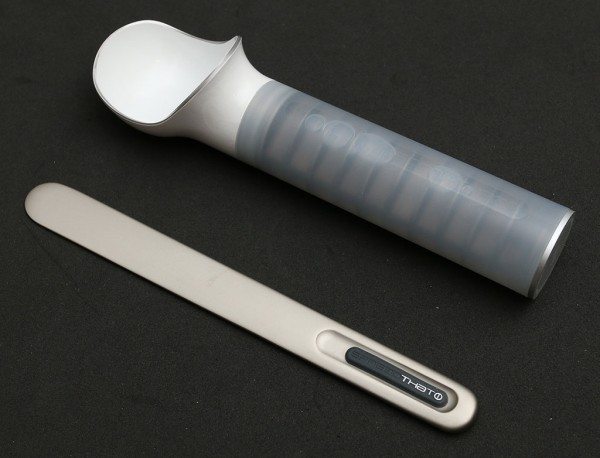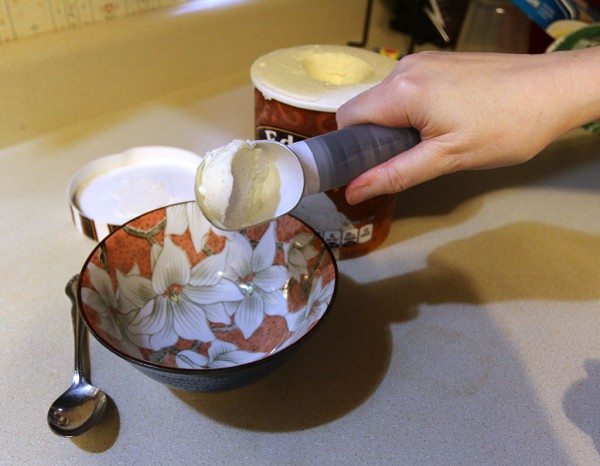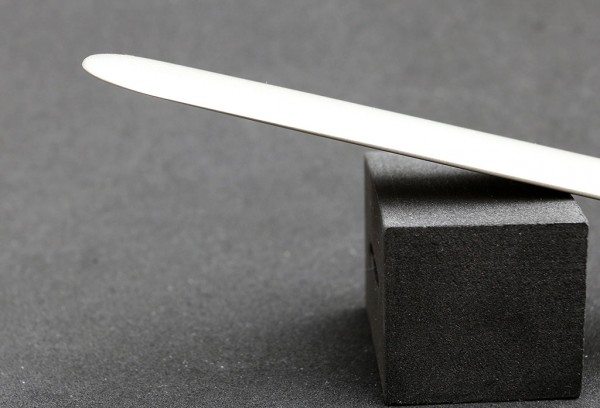I love ice cream and I love butter, but what I don’t love is having to wait for them to soften and melt so that I can scoop and spread them. Is there a solution other than just waiting? Maybe… The self-warming ScoopTHAT and SpreadTHAT ice scream scoop and butter knife claim to solve these issues. I’ve been testing samples of each. Let’s see if their claims are true.
Note: Images can be clicked to view a larger size.
ScoopThat! ice cream scoop
First up is the ScoopThat! ice cream scoop. At first glance it is a really nice scoop with a comfortable non-slip handle and large Teflon coated scoop.
Look closely at the handle in the image above, see the bubbles? The handle, which they call the energy reservoir, is a plastic cylinder which is full of liquid. It’s designed to absorb the cold from the ice cream scoop allowing the special cutting edge to easily scoop perfect frozen ice cream scoops right out of the freezer without the aid of electricity or moving parts. At least that’s the claim.
Unfortunately, in real life the experience was disappointing. I bought a brand new quart of vanilla ice cream just for the review (yeah I know, I have a tough job!). I placed the ice cream in the freezer and didn’t touch it until a day or so later, so it was definitely frozen solid. When it came time for the test, I removed the lid from the ice cream and tried to scoop it with the ScoopThat! scoop. As you can see from the image above, my scoop yielded more like half a scoop. It wasn’t any easier than a traditional ice cream scoop or just using a large metal spoon like I usually do. I thought I was probably doing something wrong, so I retrieved the packaging to look at the instructions. There were none. I looked up the product on the manufacture’s site, no instructions there either. I looked for tips on the retailer’s site who sent the sample. Strike three. So I tried experimenting by running the handle under hot water and then trying to carve out a scoop. Same results. I then turned the ice cream and ScoopThat! over to Jeanne to give it a try. Again, same results, always half scoops, never the promised perfect scoops. Even scooping the half scoops wasn’t any easier to do.
I’ll probably continue to use this ice cream scoop only because it’s well made and I don’t already have an ice cream scoop. I won’t except it to scoop any faster than a normal scoop though.
Verdict: nice idea but it doesn’t work as advertised…
SpreadThat! butter knife
I had bigger hopes for this one as we use more butter than ice cream in our house. Typically Jeanne calls me before leaving work to remind me to set out the butter so it will be softened by the time she gets home for dinner. When I forget or ignore that request, I usually get the evil eye. I didn’t want anymore evil eyes, so I was looking forward to the SpreadThat! solving that problem.
At first glance, the SpreadThat! looks more like a Titanium tongue depressor than a butter knife. It’s a hefty oblong bar of metal with a non-toxic Titanium coating. The knife is designed to transfer heat from the palm of your hand to the blade of the knife. All without electricity.
The SpreadThat! doesn’t have a sharp blade, it has a modestly thin edge on one side that is the designated cutting edge. The other side is wider and more blunt, so you need to pay attention to how you hold it since it isn’t real obvious which side is which without actually looking at it closely.
We use real butter in my house, no fake margarine junk, so the test was with a brand new stick of butter that had been placed in a glass butter dish in the fridge for a day or so. I removed the lid, placed the cutting edge of the SpreadThat! knife on the butter, pressed down and TWACK! You know that sound when the knife slides off the cold butter and hits the dish. Ok, I thought, maybe I tried cutting too thick of a slice, so I tried again. Not much better. Hmmmm… Then I rubbed my hand on my pants leg to warm it up, grabbed the knife again, held it in my hand for 20 seconds to transfer the heat and tried it again. Same result. Next I ran the knife under hot water for about 20 seconds, dried it off and tried again. Same results. None of my tests had results that were any better than a normal run-of-the-mill butter knife. Bummer.
Verdict: nice idea but it doesn’t work…
At this point I realize that just leaving the ice cream or butter out for 15-30 minutes before using is the easiest and cheapest way to go.
Source: The samples for this review were provided by Useful Things. Visit their site for more info.
Product Information
| Price: | $19.95 each |
| Manufacturer: | Thatinventions |
| Retailer: | Useful Things |
| Pros: |
|
| Cons: |
|






Gadgeteer Comment Policy - Please read before commenting
I was wondering what your verdict on this was going to look like. The ice cream scoop looks like a plastic version of the venerable Zeroll scoop that I’ve had for 30+ years. The Zeroll has the same antifreeze-type liquid in the handle — perhaps their patent expired and now we’re seeing knockoffs? — but it’s completely made of metal, which not only should conduct the heat of your hand better but also makes it easier to dig out a scoop even if the heat transfer isn’t sufficient to do the job.
I think my Zeroll is “scooper-dooper,” and recommend sticking with the original!
@Greg I was really disappointed in both products.
@Julie I wasn’t holding out much hope for the butter knife, but for the scoop I couldn’t see how a plastic handle was going to conduct heat well enough to do much good. I’m not sure that the liquid really helps that much for the scooping process itself, but the design of the scoop makes it easier to leverage the ice cream without bending the spoon. In my opinion, the liquid then helps the ice cream come off the scoop easier than regular spoons where the ice cream freezes to the utensil.
@Greg It’s a little confusing what the liquid in the handle really does. On the manufacturer’s site it says the handle is for absorbing the cold and doesn’t mention that it conducts the heat from your hand. But the packaging alludes that it does both.
we used to have a solid metal ice cream scoop growing up. It was kept on top of the fridge with the knifes. The top of the fridge was always hot. So the scoop was always hot. Run in house was, Use scoop. hand-wash it, put it back on the fridge. It always cut right through the ice cream .
@Julie, I found this on the Zeroll website history page, talking about the fluid-filled handle:
In 1933, Sherman Kelly developed the design for the Zeroll® Ice Cream Dipper and received a patent. The dipper was a non-mechanical ice cream scoop, made of cast aluminum, with fluid inside the handle. Its unique design transferred heat from the user’s hand, warming the fluid, which in turn defrosted the ice cream dipper. There was no longer a need to rinse the dipper in water between servings.
Yes, that’s what I thought.
(On a different topic, I closed the browser tab the first time the ads played with sound. As a long time reader, I thought I should let you know. Also, it seemed to make your site nonrespsonsive )
@meistervu if you see another ad with sound, get a picture of it so I can have it blocked.
Julie, I would not have made a purchase of the butter knife had I read your post first. I did buy a red one and found that it works pretty well for me. I had to experiment with it a little bit. I found that if I scrape along the stick of butter (and this part works just like any knife so nothing spectacular) and after getting a bunch of scrapped butter onto my toasted bagel, the knife magically worked! A lot better than ordinary knifes because ordinary knifes do not do anything at all. My 10year old kid tried it on regular toast and she liked the knife better than regular knife too. So at least for me it was a pretty good purchase.
@Sam thanks for your comments. I just don’t find it worth $19.95 if it doesn’t significantly aid in cutting and spreading. If I have to cut thin slivers in order for it to work, I can do that with a regular knife. Thin slivers with a regular knife on a hot roll or toast will spread just fine. Also from what I’m reading, we don’t even really need to refrigerate our butter in the first place…
I think the real problem is not in the scoop, but is the temperatures that the ice cream and butter are being stored at.
My spouse was raised in Ireland in the early 1950s and she never put butter in the refrigerator. They left the butter out in the cupboard with a cover on it.
They didn’t die of botulism or salmonella. The butter was soft and creamy. There are many sources that support this idea of a covered butter dish in the cupboard as safe.
And if the idea of butter just sitting there to grow bacteria or go rancid grosses you out, there is the French-style butter keeper that inverts butter in a container filled with water. Keep that on the table or cupboard for very soft butter.
BTW, the fresher the butter, the less likely it is to go bad.
Now, as to that ice cream.
Our freezers are way, way too cold. Even the original information of the Zeroll which the ScoopThat! was based on, says it works in slightly frozen ice cream.
But there was a movie out about 20 years ago that showed someone throwing ice cream into the microwave for maybe 10 to 15 seconds. It came out perfect for scooping.
@Sandee when I visited Scotland years ago, they kept the butter out on counter too. We are lacking in counter space at my house, so I think I’ll just have to keep going with the take it out 15-30mins in advance of using it technique. Same goes for ice cream. Both actions cost $0 🙂
A ha! You have to warm the knife on a warm bagel.
We nuke our ice cream for 5 sec to soften it.
@johnkes I’ve never tried that. I think I’ll need to run an experiment tonight 😉
I guess I’ll just have to keep looking for the perfect ice cream scoop – maybe a heated, USB rechargeable one.
As far as nuking ice cream, it works great for single serving packages (like a Haagen Dazs pint?) but otherwise you end up with ice crystals in the unused, refrozen portion.
My baguettes and toasts cool down so fast out of the oven it’s driving me crazy! I’ve always had trouble spreading with regular knives no matter how thin the slices of butter I make so I am intrigued. I have a broad knife and running it under hot water only helps for like 10 seconds before it cools down too. Do you think this will help me out if I cut away butter slices like I did before? Thanks!
@Kathy my experience with the SpreadThat! was not favorable… even when running it under hot water. I’d skip it…
Nuke it just enough to soften. You definitely don’t want to melt it to liquid, and make it lose its fluff.
Highly recommend the Hagen-Dazs Concerto app. Beautiful music, classical buildup of anticipation, and sweetness for the coda! Also, I never seem to have ice cream left over in which to get ice crystals…
No surprise here. Marketing doublespeak can not trump thermodynamics.
Anything that says it will “absorb the cold” is automatically suspect. Similarly, light bulbs don’t “suck the dark out” of a room.
@Tom
Well if they don’t “suck the dark out” is it that when you turn the bulb off that the light gets sucked back into the bulb?
Don’t scoop – scrape the ice cream, a lot easier. That’s how shops do it. It gives you the appearance of having more ice cream than you actually do. Also it gives you more surface area of ice cream which directly contributes to how much ice cream you actually taste.
And unless you want more food intake (I do, as I can’t gain weight no matter what), taste is what you are after, not amount of food intake.
Next step of something to test, for butter: https://www.kickstarter.com/projects/1070983896/the-stupendous-splendiferous-butterup
Looks like and interesting idea, and it could work. (I’ve found slicing cold butter thin enough works fairly well, so this is basically a helper for that.)
Thank you for testing the speader. I literally just ordered this from Amazon and they were out of stock. I have cancelled the order. Disappointing.
Thank you Julie, I decided to get one anyway. Just saw Kathy Lee Gifford’s endorsement and read the FAQ on their web site with some tips. Will try it and let you know!
@Kathy please do let me know your thoughts.
Ice cream a cops take some technique but a little practice will have you pulling perfect scoops. You don’t use it like a spoon but dig the tip in at one end of the container and drag it to the other. The ice cream will rise up toward the handle and continue until it rolls up into itself. How deep you first dig will depend on how full or hollow the ball is
Apparently Thatinventions has started a kickstarter themselves (https://www.kickstarter.com/projects/that/heated-butter-spreader) to try and improve upon the functionality of the SpreadThat! They’ve been pretty vague about how they are planning on improving it though. Still could be interesting to see if version 2 actually works.
@David I remain skeptical that this isn’t the same one they are already selling…